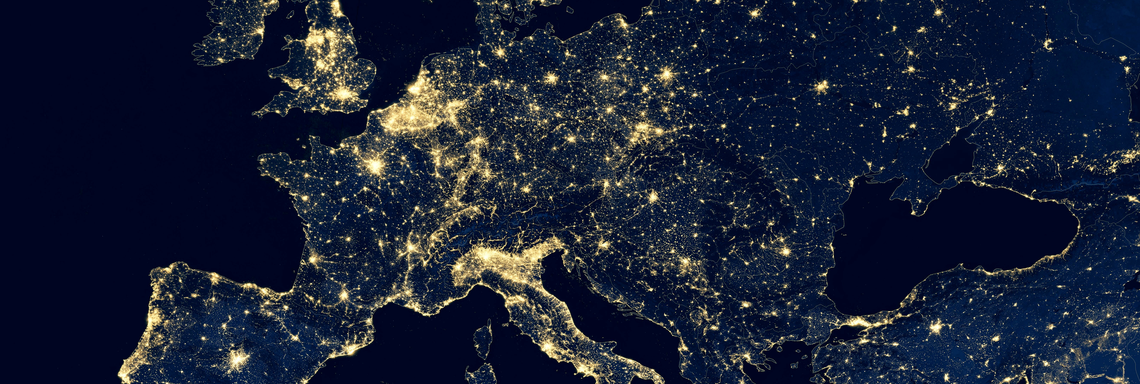The saving of energy and the „cosmic” technologies
A human has to soar above the Earth – to the top of the atmosphere and beyond it – because only in this way s/he will understand the world in which s/he lives.
Sokrates, around 500 rok B.C.
To be able to match the requirements of the market, i.a. OSD reshapes the traditional energy infrastructure in the direction of the smart grid, the producers of energy shift to renewables and consumers try to rise to the imposed requirements concerning the energy efficiency of equipment, buildings, and whole organizations.
The energy transformation to such an extent won't come to fruition without the support of the ICT. The strategies of the energy concerns indicate the huge change, not only in the area of the energy mix but also to the new approach towards energy services. In connection with this, the natural path to building the business worth is the ability to recognize and testing of many technologies and ICT solutions. One of them is the Internet of Things (IoT). It is a concept, in which objects can directly or indirectly accumulate, process, or exchange data via intelligent, electric installation KNX or a computer network.2 Codes QR, NFC (near field communication), wearable devices, or Beacons – are some of the already functioning expressions of the IoT, which contribute to the improvement of energy efficiency.
Willing to save not only energy but also finances it is worth finding a solution, whose implementation doesn't require capital investment and, what is important, is conducted by experts, knowing not only the questions regarding energy efficiency as well as ICT. The could technology enables very fast implementation of solutions, thanks to placing of the application in the preparation for action IT environment. At the same time, we can offer prepared earlier solutions in the SaaS model (Software as a Service)3 which is a service one.

What exactly is ICT?
ICT plays a significant role in solving global problems, which are climate change, hunger, or poverty. They successfully support the management of energy efficiency. Both the UN and the EU emphasize the development of implementations of the ICT, getting the digital expertise, and the fight against the digital exclusion of the societies. As the UNEP report show, the solutions offered by the ICT sector can to the large extent contribute to easing the unfavorable climate change.
The acronym ICT was disseminated in the EU states via the documents of the OECD and the EC. The potential of the ICT branch lies among others in the dynamic development of the systems serving to obtain, transforming, and managing the great compilations of data (Big Data) and the efficient communication which is enabled by the technology of the Internet of Things (IoT), basing on the conviction that the net can connect not people with each other but also people with things and objects.
The additional technologies which can be used in Big Data, include the big scale, the parallel transformation of the databases, the applications based on the exploration of data, the dispersed systems of files, the dispersed databases, the cloud infrastructure (applications, transformation resources, memory) and the Internet. The real or almost real-time of delivering of information is one of the crucial characteristics of Big Data analysis.

Lem już dawno to przewidział
The parliament of the Republic of Poland established 2021 The Year of Stanisław Lem.4 In doing so it honored one of the most outstanding Polish prose writers, the most widely translated author of hard science fiction, philosopher, futurologist, and critic, who more than half a century ago predicted the development of the ICT. In the famous „Dialogs” from 1957, he presented the usage of modern technology as a real direction of the technological development writing that „as a result of gradual accreting of all the IT equipment and memory banks the continental and maybe even planetary computer networks will be created”. The technological progress and the development of the Internet create unlimited possibilities. That's why in the year of Stanisław Lem it is worth looking at the modern ICT through the eyes of the genius and the benefits, which come from their applications.
The efficient usage of energy in the economy is a very important factor influencing the level of production costs, the company profits, and the competitiveness of products and services. The enhancement of the energy productivity can be obtained in the sectors using energy the most which are the industry and construction, in which there is a great potential for modernization actions.
The EU policy is oriented towards the enhancement of energy efficiency. The introduction of the more advanced methods of management of energy requires the evaluation of the usage of fuels and energy by a recipient, connected with the identification of ways of the rationalization of its usage, the energy audit. The obtained data will enable the analysis of the real demand to implement the optimal and effective models of management of the processes connected with the usage of energy. The broadband grids and the advanced grid services are en masse used in everyday life. Their functionality includes the rational management of the general-use equipment, intelligent houses, cities, telemetry, and navigation. The new generation interfaces enable the migration of the human surrounding from passive objects to the intelligent, active environment of services, ensuring permanent access to resources. The integration of the massive amount of data with information in the grid and a client is a great potential for the development of the analytical systems in energy production, including the systems of incident management. The convergence of the information and operational technologies means the integration of such technologies for example the management of the energy distribution in real-time on the level of the transmission grid and the sub-station with the ICT systems, supporting the operation of counters, the business processes connected with client service, analytics, and the billing systems. It enables also achieving goals connected with the formulation of the consistent, singular outlook at the systems of information management in the organization, which will bring data in a proper format, to the right persons at the right time, which will considerably streamline taking decisions.
The usage of the satellite data and the implementation of the space technologies
To better understand the benefits coming from the implementation of the ICT in energy efficiency management it is worth analyzing the usage of satellite data and space technologies. Thanks to the satellite displays we monitor the traffic, observe parking spots or airports. On the one hand, we analyze the satellite displays for the health security of the population or the state of the environment (for example quality of air, weather forecast) and on the other hand, we examine the influence of changes taking place on the economy. The satellite remote sensing contributes to taking more accurate decisions by the public administration, it helps scientists in better understanding of phenomenons and processes taking place on our planet and helps recipients for example farmers in using specialistic applications in their farms to optimize yields and running precise farming. Thanks to the common access to the satellite data via different services, the users can use displays gathered in resources of the volume counted already in petabytes.
More and more often its processing takes place in the mentioned computing clouds without the need for the direct downloading of pictures to a computer disc and the results are passed to the application specially created for this purpose. The consequences of climate change, the increasing environmental pollution, the considerable increase of the population in many areas of the world, and other processes leading to the deterioration of life quality or the increase in threat for human health and existence, often resulting from the crises or how it happened later, caused by the pandemic of the virus SARS CoV-2, considerably influence the speeding up of the space technologies development and also the possibilities of obtaining data on the environment of Earth.

The satellite technics, and also the methods of advanced processing and the analytics of a large number of diverse datasets (including pictorial and meteorological ones) contribute to the better understanding of occurring phenomenons and processes and their successful monitoring, registering as also forecasting. A good example of policy responding with fairness to these challenges is a program Earth” (DestinE).5 Its goal is to formulate the precise, digital model of the phenomenons occurring on Earth to be able to monitor and at the same time stimulate them and also the anthropogenic factors and prepared and tested scenarios, enabling the sustainable development of humanity with ensuring the support of the European environmental policy. The effect of the program on a global scale will be the release of the digital of the potential modeling of the physical resources of Earth and phenomenons connected with them like the climate change, water, marine environment, polar areas, cryosphere, and such like, what in consequence is to speed up the „green transformation” and support the initiatives of preventing farther degradation of the environment or the environmental catastrophes.

Achieving such ambitious goals, which are set by the governments of respective states, operators of the satellite systems, and private investors become possible to realization only thanks to the broad, international cooperation, engagement of scientists, entrepreneurs, and interested citizens. The awareness of usage of the great informational potential gathered in the images and satellite data will increase the efficiency of work being done by the public administration in favor of the sustainable management of the environment, the restoration or raising the quality of life, and the security of citizens.6 We can thoroughly identify and measure the areas affected by drought, fires, or floods. Farmers optimize the production based on satellite displays, regulating the irrigating and fertilization with the benefit for the environment. We can forecast and monitor among others the settling of land, especially important for the safety of inhabitants in the mountain areas and big cities. The facility of usage of the satellite data and the diminishing of the barriers of their usage can help in offering concrete, intuitive solutions/services with an accessible interface. Their common usage, analysis, and interpretation and also inclusion into an analysis of data of a different origin (for example statistical, social ones) give a chance for obtaining special information on phenomenons, processes, and objects, and trends with multi-time analysis. The advanced analysis of data entails the usage of Big Data technics, Artificial Intelligence including machine learning, IoT, modern programming languages, statistics, and such.
Examples of good practices
- Sat4Envi7 - portal aimed at disclosing satellite data for the monitoring of the natural environment of Poland. The platform relies on the earlier existing and already modernized resources of the Institute. The project is realized by the Institute of Meteorology and Water Management National Research Institute (pol. IMGW-PIB) in cooperation with Partners – Centrum Badań Kosmicznych Polskiej Akademii Nauk (the Center for Space Research), the Academic Computer Centre CYFRONET AGH and POLSA.
- VEMS (Virtual Energy Management System)8 - algorithm analyzing the information from the ticket system, VEMS accommodates heating, ventilation, and air conditioning to the number of persons in the cinema room. Thanks to that the operators of a cinema save from 15% to 25% of energy usage, record-holders even above 50%.
- Global Forest Watch9 - analysis of covering of Earth with forests and following deforestation used for example by Rainforest Foundation US, Global Wildlife Conservation, the World Bank, or National Geographic. Thanks to it the illegal logging in Peru by united Cacao or illegal logging in Uganda was discovered.
- Case study - Application Windy10 - presents data concerning the air quality, delivered to forecast the pollution of the surface air, ozone, and aerosol vapors.
Recommendations
To obtain the positive and measurable effects of the energy transformation we need to widely promote the development of the market of intelligent services. The usage of the results of the methods of the evaluation of infrastructure investments in respect of energy efficiency will pay dividends through the decrease of the negative influence on the environment. Not less important is the information and education aspect.
Author:
Anna Szóstakiewicz, Krajowy Ośrodek Zmian Klimatu IOŚ-PIB
1http://hamlet.edu.pl/sokrates
3https://poradnikprzedsiebiorcy.pl/-saas-oprogramowanie-jako-usluga
5https://ec.europa.eu/digital-single-market/en/destination-earth-destine
6https://polsa.gov.pl/dane-satelitarne/
8https://www.ushio.com/product/vems-virtual-energy-management-system/




